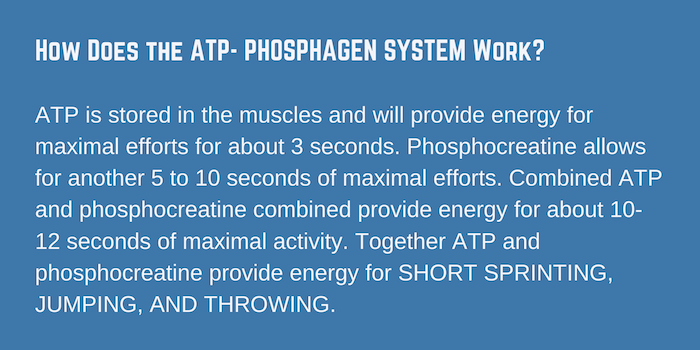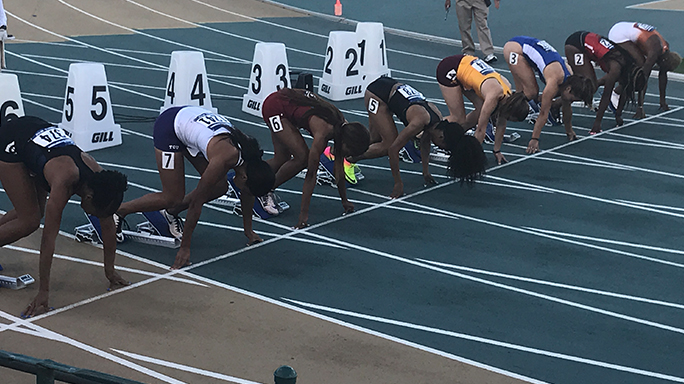Acceleration Training for Speed
Sprint training programs are designed to improve speed and explosive power to maximize speed. All athletes looking to improve speed and performance will benefit from acceleration and max velocity training. Acceleration is defined as the change in velocity per unit of time; in sprinting, acceleration concludes when velocity is no longer increasing.
Proper acceleration requires muscular coordination to execute the technical movements and high levels of force to push down into the ground.
Short quick steps with forward body lean, drive horizontally with a gradual transition to more vertical movements. Think stride frequency at the start of the race.
The Secret of Speed
Speed workouts for track and field will include several factors for the coach and athlete. Everyone is looking for the magic workout or the one key to success in the top programs, well, here is the secret:
RUN FAST IN PRACTICE and RECOVER PROPERLY
Starting Speed
Starting speed is the ability to accelerate from the starting position to maximum speed in the shortest time possible; the ATP-Phosphagen Energy System and technical efficiency are the two primary factors involved in starting speed.

The acceleration phase of the race propels the athlete forward and upward. Forces are generated horizontally (forward) toward the finish line and vertically (upward) to counteract gravity.
Acceleration training is closely associated with horizontal force development, whereas maximum velocity training is related to vertical force development.
Sprinters transition from more horizontal and less vertical to a more vertical extension during the later phases of the sprint movement. Horizontal forces create greater acceleration during the start of the race to overcome inertia; vertical forces are more prevalent during the later stages of the short sprint races.
Acceleration Development
Every race has an acceleration component to overcome inertia.
The drive phase is developed with training activities to improve the first 40 meters of the race. Specific movements related to acceleration using higher intensities (90%+) with proper rest periods (1-3 minutes) between activities are required to improve the drive phase.

Acceleration Sprint Training
Acceleration training is designed to get the explosive starts needed in sprinting and other activities. Sprint training programs include drills and exercises specifically designed to improve speed and explosive power to maximize athletic performance. Yes, sprinters will benefit from this acceleration program but so will all types of athletes that need speed and explosion during a competition.
Acceleration (Speed) Training Overview
- Intensity: 95-100%
- Repetition Duration: less than 7 seconds (up to 50 meters)
- Total Volume: 300m-800m
- Recovery: 1-2 minutes per 1 second (10 meters) of work
- Time Between Sessions: 48+ hours
Sample Acceleration Workouts
- 8 x 30 meters - 3-minute recovery
- 6 x 20 meters - 4 minute recovery + 6 x 30 meters - 3 minute recovery
- 10 x 30 meters- 5 minute recovery
Principles of Track Workouts For Speed
Speed Development
- All runners need speed
- Great sprinters have 100-400 meter range
- Sprint fast in training to sprint fast in competition
Training Elements
- Train to race and compete
- Train race tempo
- Train strength and power
- Train athlete abilities
- Train race specific speed
Training Sprinters
- Acceleration Phase
- Maximum Velocity Phase
- Training Methods
- Planning Overview
- Quality over Quantity
Workouts For Speed
Acceleration Phase
Train to overcome inertia from static position
Train rhythm of the run with acceleration line drill
Acceleration training with starts
- 2-point start
- Rolling start
- 3-point start
- 4-point start
- Block starts
- Half starts
- Resistance starts (10-40 meters)
Maximum Velocity Phase
Train top end speed
Develop higher tolerance for faster paces
Train in 20-30 meter segments
Use various build in distances
Acceleration 20-40 meters + 20-30 meters Max Velocity
Train maximum velocity rhythm with wicket drills
Acceleration and Maximum Velocity Training Methods
- Ins and outs
- Resisted runs
- Assisted runs
- Power training
Ins and outs
30-meter acceleration sprint 10-15 meters - off 15-20 meters - sprint 10-15 meters (3-4 minute recovery)
Sprint phase: go for maximum speed, maintain sprint mechanics
Off phase: decrease intensity and cadence, maintain body positions
*use cones for changes in speed
Resisted Runs
- Weight vest (up to 10% body weight)
- Sleds (pulling weight) combine with start options
- Hills (short or long depending on training component)
- Stairs (develop acceleration and max velocity)
(3-4 minute recovery)
*change the intensity with more weight or higher slope grade
Assisted Runs
- Bungee and pulley for over-speed
- Downhill sprints 1.5- 3% slope grade
*60 meters or less (under 6 seconds)
* speed within 10% of personal best
Power Development
Specific preparation exercises for acceleration include training to increase muscular strength in the lower body, jumps and throws with horizontal components, power development, reactive strength, and other movements that require high rates of initial force to overcome inertia.
Power Training (Jumps)
- Standing long jump
- Standing triple jump
- 3 double leg jumps
- 5 double leg jumps
- 10 double leg jumps
Power Training (Bounding)
- Acceleration bounds
- Max velocity bounds
- Single leg bounds
- Speed bounds
- Long bounds
Power Training (Throws)
- Overhead shot throw for distance
- Forward shot throw for distance
- Forward medicine ball throw for height
- Hammer style throws for distance
Power Training (Jump/Throw Combo’s)
- Hop – hop - forward shot throw
- Hop – hop overhead throw
- Backward hop – backward hop – overhead throw
- Backward hop – backward hop - forward throw
- Hop - hop - throw for height
Power Training (Jump and/or Throw/Sprint combo’s)
- Hop – hop – forward throw into sprint 10 meters
- 3 double leg hops into sprint 10 meters
- Forward throw –into sprint 20 meters
- Acceleration bounds 10 meters into sprint 10 meters
Review
All running starts with an acceleration phase followed by a maximum velocity phase. Ground contact times are longer during the acceleration phase with an emphasis on the horizontal drive.






